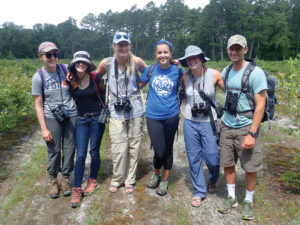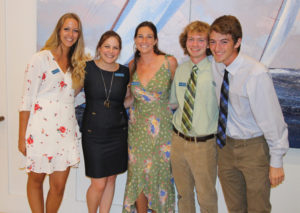Coastal Conservation Research Program

2018 CCRP Interns, L to R: Kirstine Grab, Amanda Lyons, Amanda Lillie, Jamie Infanti, Sarah Kerr, Danny Stoner (Photo taken by 2018 CCRP Coordinator: Steve Luell)
It was a busy, muddy summer with the Coastal Conservation Research Program interns. We were able to learn so much through their contributions, and had a great time doing it! The crew of six– all undergraduates or recent graduates – helped us collect data to monitor diamondback terrapins, coastal birds, horseshoe crabs, and, of course, the wetlands. In addition, they contributed to data analysis, outreach programs, and so much more, all the while gaining new experience with field skills, analytical approaches, and professional development that we hope will help them along their path. A significant portion of their summer was dedicated to the development and completion of independent research projects that included writing and delivering research proposals, collecting and analyzing data, and presenting the results of their work. They all showed off their accomplishments at our Annual Intern Symposium on August 6.
Several of our projects this year advanced our work with Diamondback Terrapins. Kirstine Grab (University of Minnesota) located head-started terrapins using radio telemetry and examined habitat characteristics of their positions. Sarah Kerr (Clemson University) compared mass-specific physiological differences in head-started terrapins. Amanda Lillie (Tufts University) evaluated our efforts to decrease mortality of nesting terrapins on coastal causeways. Amanda Lyons (Brown University) compared methods for surveying terrapin in tidal creeks to determine a more efficient and effective methods for future study. Meanwhile, to contribute to our studies of coastal birds, Jamie Infanti (University of Connecticut) monitored behavior and nest site selection of a mixed species colony of skimmers and terns. Daniel Stoner (Kutztown University) explored habitat use and characteristics of Laughing Gull nests on a salt marsh island.
Educators Leading the Way

2018 EE Interns, L to R: Diana Moczula, Brooke Knapick (Director of Education), Samantha Najarian, Gregory Fischer, Joseph Hernandez.
The Wetlands Institute’s Environmental Education Interns spent 12 weeks leading public education programs, while immersing themselves in the unique environment of the surrounding salt marsh and barrier islands. They worked hard and through it all developed the skills they need to continue their careers in environmental education. Each year, interns are asked to develop and implement an education project of their choosing that is personally and/or institutionally beneficial. The deliverables from their projects leave a lasting impact on The Wetlands Institute and we hope you’ll stop by to see their education initiatives in action.
Gregory Fischer (Stockton University) created a new general admission visitor program Science Feature to educate the public on soil science, dredging, and the use of dredged materials, including The Wetland Institute’s work on the Beneficial Use Project. Joseph Hernandez (Stockton University) developed educational signage and an accompanying 125-gallon brackish water aquarium tank that includes schooling fish, ribbed mussels, fiddler crabs and other salt marsh species, to highlight the importance of salt marsh organisms. Diana Moczula (Carleton University) translated 25 years of terrapin tracking research data into an educational terrapin tracking display that consists of unique terrapin profiles and an interactive microchipping and mapping activity. Samantha Najarian (College of Charleston) bolstered the learning components of popular boathouse-based (Herd Building) programs, including Catch o’ the Day, Hooked on Fishing, and Crabbing, by creating new visual resources, including a marine themed art display for inside the Herd Building, and complimentary children’s activities.
